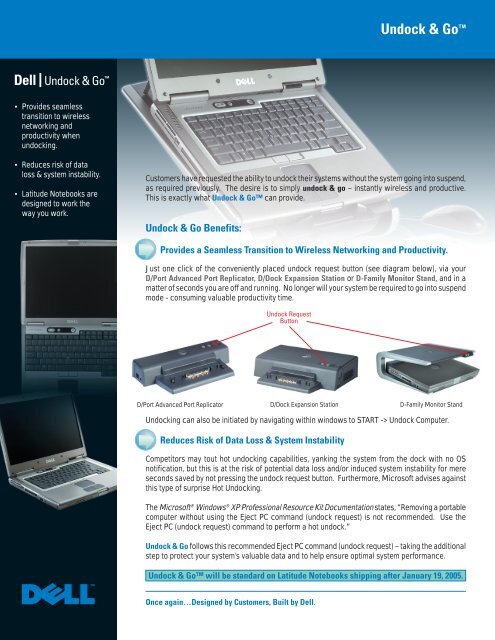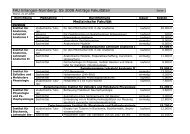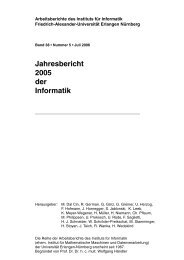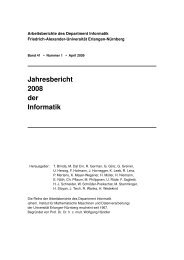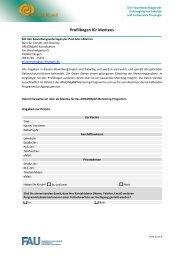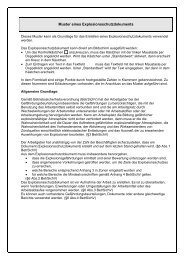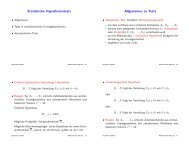You also want an ePaper? Increase the reach of your titles
YUMPU automatically turns print PDFs into web optimized ePapers that Google loves.
<strong>Undock</strong> & <strong>Go</strong> TM<br />
• Provides seamless<br />
transition to wireless<br />
networking and<br />
productivity when<br />
undocking.<br />
• Reduces risk of data<br />
loss & system instability.<br />
• Latitude Notebooks are<br />
designed to work the<br />
way you work.<br />
Customers have requested the ability to undock their systems without the system going into suspend,<br />
as required previously. The desire is to simply undock & go – instantly wireless and productive.<br />
This is exactly what <strong>Undock</strong> & <strong>Go</strong> can provide.<br />
<strong>Undock</strong> & <strong>Go</strong> Benefits:<br />
Provides a Seamless Transition to Wireless Networking and Productivity.<br />
Just one click of the conveniently placed undock request button (see diagram below), via your<br />
D/Port Advanced Port Replicator, D/Dock Expansion Station or D-Family Monitor Stand, and in a<br />
matter of seconds you are off and running. No longer will your system be required to go into suspend<br />
mode - consuming valuable productivity time.<br />
<strong>Undock</strong> Request<br />
Button<br />
D/Port Advanced Port Replicator D/Dock Expansion Station D-Family Monitor Stand<br />
<strong>Undock</strong>ing can also be initiated by navigating within windows to START -> <strong>Undock</strong> Computer.<br />
Reduces Risk of Data Loss & System Instability<br />
Competitors may tout hot undocking capabilities, yanking the system from the dock with no OS<br />
notification, but this is at the risk of potential data loss and/or induced system instability for mere<br />
seconds saved by not pressing the undock request button. Furthermore, Microsoft advises against<br />
this type of surprise Hot <strong>Undock</strong>ing.<br />
The Microsoft ® Windows ® XP Professional Resource Kit Documentation states, “Removing a portable<br />
computer without using the Eject PC command (undock request) is not recommended. Use the<br />
Eject PC (undock request) command to perform a hot undock.”<br />
<strong>Undock</strong> & <strong>Go</strong> follows this recommended Eject PC command (undock request) – taking the additional<br />
step to protect your system’s valuable data and to help ensure optimal system performance.<br />
<strong>Undock</strong> & <strong>Go</strong> will be standard on Latitude Notebooks shipping after January 19, 2005.<br />
Once again…Designed by Customers, Built by Dell.
D/Port D/Dock D-Family D/View<br />
FEATURES Advanced Port Replicator Expansion Station Monitor Stand Notebook Stand<br />
Key Product Features Provides Port Replication Provides extra desktop Supports external CRT or Flat Eliminates need for a pricey<br />
alleviating the need to re-connect expansion over the Panel up to 100lbs/45kg. Requires external monitor & saves<br />
peripherals each time you return D/Port with a PCI Slot a D/Port or D/Dock to function. up to 40% desktop space.<br />
to your desk. & D/Bay Module Bay. Requires D/Port to function;<br />
Will NOT work with D/Dock.<br />
D/Bay Module Bay N/A Via D/Dock Only N/A<br />
PCI Slot* N/A Via D/Dock Only N/A<br />
<strong>Undock</strong> & <strong>Go</strong> Via D/Port or D/Dock Via D/Port Only<br />
Ports Supported Via D/Port or D/Dock Via D/Port Only<br />
RJ-11 (Modem) Via D/Port or D/Dock Via D/Port Only<br />
RJ-45 (Ethernet) Via D/Port or D/Dock Via D/Port Only<br />
S-Video Via D/Port or D/Dock Via D/Port Only<br />
DVI-D (Digital) Via D/Port or D/Dock Via D/Port Only<br />
VGA Via D/Port or D/Dock Via D/Port Only<br />
Parallel Via D/Port or D/Dock Via D/Port Only<br />
Serial Via D/Port or D/Dock Via D/Port Only<br />
PS/2 (x2) Via D/Port or D/Dock Via D/Port Only<br />
S/PDIF (Digital Audio) Via D/Port or D/Dock Via D/Port Only<br />
USB 2.0 (x4) Via D/Port or D/Dock Via D/Port Only<br />
D/Bay Connector Via D/Port or D/Dock Via D/Port Only<br />
Headphone Via D/Port or D/Dock Via D/Port Only<br />
Power Button Via D/Port or D/Dock Via D/Port Only<br />
<strong>Undock</strong> Button Via D/Port or D/Dock Via D/Port Only<br />
Eject Latch Via D/Port or D/Dock Via D/Port Only<br />
Kensington Lock Via D/Port or D/Dock Via D/Port Only<br />
AC Adapter / 90 W Adapter Power Cord ONLY; Via D/Port or D/Dock Via D/Port Only<br />
Power Cord<br />
130W built in Dock<br />
System Compatibility Latitude D400, D500, D505, D600 Latitude D400, D600, D800; Latitude D400, D500, D505, D600 Latitude D400, D500, D505, D600<br />
D800; Inspiron 8500, 8600, 500m, Inspiron 8500, 8600, 500m D800; Inspiron 8500, 8600, 500m, D800; Inspiron 8500, 8600, 500m,<br />
510m, 600m; Dell Precision M60 510m, 600m; Dell Precision M60 510m, 600m; Dell Precision M60 510m, 600m; Dell Precision M60<br />
Physical Height: 53mm (2.09”) Height: 70mm (2.76”) Height: 136mm (5.36”) Height: 101.9mm (4.01”)<br />
Measurements Width: 142mm (5.59”) Width: 160mm (6.30”) Width: 344mm (13.56”) Width: 333.68mm (13.14”)<br />
Depth: 276mm (10.87”) Depth: 312mm (12.28”) Depth: 365mm (14.37”) Depth: 420.8mm (16.57”)<br />
Weight: 0.79kg (1.7 lbs) Weight: 3.0kg (6.6 lbs) Weight: 3.5kg (7.82 lbs) Weight: 3.6kg (7.9 lbs)<br />
*PCI Slot on D/Dock supports Full-Height (106.68mm / 4.1”), Half-Length (167.64mm / 6.6”) PCI cards. Both the D/Port & D/Dock ports are pass-through only.<br />
<strong>Undock</strong> & <strong>Go</strong> Details:<br />
<strong>Undock</strong> & <strong>Go</strong> utilizes Informed Hot <strong>Undock</strong>ing which refers to informing the<br />
OS that an undock will take place, as opposed to un-informed hot undocking<br />
where a system is removed from the dock without OS notification that the<br />
system will be separated from the dock. Neither Dell nor Microsoft supports<br />
un-informed undocking, hot or warm (suspend mode).<br />
What’s New<br />
The latest Dell Latitude Notebooks, shipping as of January 19, will no longer<br />
suspend upon undocking. The user will now see an OS message informing<br />
you that it is safe to undock.<br />
In Windows XP, a few seconds after an undock request is made, a bubble<br />
message will appear just above the systray, via the “Safely Remove Hardware”<br />
icon saying: “<strong>Undock</strong> Complete - Windows has finished undocking the system.<br />
If you need to remove the system from the Docking Station, please do it now”.<br />
The amount of time, typically 2-4 seconds, before this message appears will<br />
be system and especially driver load dependant. Windows is in control of this<br />
message and under Windows XP the <strong>Undock</strong> Complete message will only be<br />
present for approximately 5 seconds before it disappears. The D/Dock and/or<br />
D/Port will also alert you with a lit LED on the Eject Button. Previously, prior to<br />
<strong>Undock</strong> & <strong>Go</strong>, the customer knew it was safe to undock when the system<br />
went into suspend and the power LED was “breathing”.<br />
In Windows 2000, the messaging is very similar, except to navigate by Windows<br />
it is START -> Eject PC and the “<strong>Undock</strong> Complete” message is worded the<br />
same but appears in a centered dialog box and remains until the user hits the<br />
OK button in this dialog box.<br />
After the “<strong>Undock</strong> Complete” message appears, the BIOS will give the user 40<br />
seconds to undock. After the 40 seconds has elapsed and the system has not<br />
been removed from the dock, the system will automatically re-dock. The eject<br />
LED will go out after the automatic re-dock. The user can issue another undock<br />
request at this point if undocking is still desired.<br />
© Copyright 2004 Dell Inc. All rights reserved. Dell and the Dell logo are trademarks of Dell Inc. Microsoft and Windows are registered trademarks of Microsoft Corporation. Other trademarks and<br />
trade names are used to identify the entities claiming the marks and names of their products. Dell Inc. disclaims any proprietary interest in trademarks and trade names other than its own.


